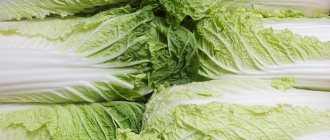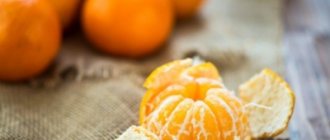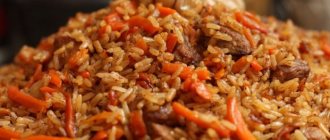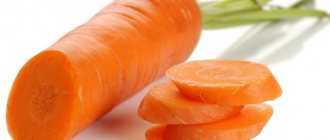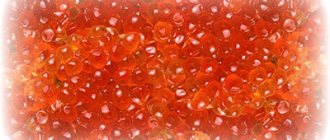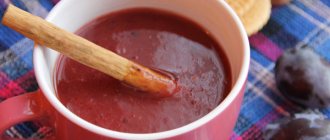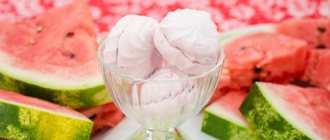Breastfeeding is a natural way to give your baby all the microelements he needs to live. The composition of mother's milk changes depending on the needs of the child's growing body. But a woman herself must receive enough nutrients to feel healthy and energetic. This is why it is so important to provide a nursing mother with a balanced diet. Doctors categorically do not recommend eating certain types of foods while breastfeeding. Other types, on the contrary, are strongly recommended. Let's figure out whether it's possible to eat colored vegetables. After all, this vegetable is a real storehouse of vitamins, and it’s also very tasty and satisfying.
How to choose and store correctly
Broccoli and cauliflower are very beneficial for breastfeeding due to their protein content. They can easily replace meat dishes for vegetarians. But you need to be able to choose the right crop in which all the beneficial properties are preserved.
Judging by the reviews of cauliflower lovers, its leaves should be green and not limp, without traces of insect activity, any spots, or yellowness. This indicates that the vegetable was picked recently and is fresh. The inflorescences themselves can be white, yellowish or greenish. Dark spots on them are a sign that the cabbage has begun to deteriorate. This vegetable should not be eaten. It is not recommended to store cabbage in the refrigerator for more than a week. But you can freeze the inflorescences. Moreover, all the beneficial qualities will be retained even after defrosting by a wonderful vegetable - cauliflower.
When breastfeeding, the recipe for preparing it must necessarily contain a heat treatment step. The inflorescences can be boiled, stewed, baked in the oven, cooked in a slow cooker or steamed.
Benefits and harms
The introduction of any variety of inflorescences into the menu of a young mother when breastfeeding begins, as a rule, with soups and broths. Then you can stew or steam, but frying is strictly not recommended. When heat treated, vegetables gain the ability to be digested better and absorbed faster. The beneficial properties are preserved, which means that stewed cabbage is not prohibited for a nursing mother and is completely safe.
Read also: Is it possible to have coffee while breastfeeding (BF) - Komarovsky (Video)
It has a lot of useful features:
- strengthens the immune system and has a general strengthening effect;
- regulates cholesterol levels in the blood;
- removes toxins;
- strengthens blood vessels;
- protects the retina of the eyes from the negative effects of UV rays;
- struggles with loss of strength;
- reduces the risk of blood clots and cancer cells;
- helps prevent sclerosis;
- improves the condition of skin, hair and nails.
Due to increased acidity, consuming stewed inflorescences is not recommended for people with ulcers or gastritis, or intestinal spasms. In this case, it is better to abandon the vegetable or consult a specialized doctor. If your baby has signs of colitis, then it is also necessary to limit consumption.
with cheese
- 1 head of cabbage;
- 1 egg;
- 100 gr. hard cheese;
- 3 tbsp. l. mayonnaise or sour cream;
- herbs, salt and pepper to taste.
Divide the cabbage into inflorescences, wash thoroughly and place in boiling and salted water. Cook for 5-7 minutes over medium heat, covered. Drain the water, cool the cabbage and place it on a greased baking sheet with the florets facing up in one layer. Beat the egg, add sour cream, grated cheese, finely chopped herbs. Pour the resulting mixture over the cabbage and place in the oven for 10-15 minutes. The dish is ready when the cheese has melted and the cabbage has acquired a beautiful golden crust.
Light soup
You will need:
- 1 head of cauliflower;
- 3 potatoes;
- 4 tbsp. l. rice;
- carrot;
- vegetable oil;
- salt, pepper, herbs.
Wash and peel the vegetables. Cut the potatoes and onions into cubes, carrots into strips, and disassemble the cabbage into inflorescences. Rinse the rice and pour cold water to remove excess starch. Throw the potatoes, half the carrots and onions, and rice into boiling water and cook for 15 minutes. Pour oil into the frying pan, add the remaining half of the onions and carrots, stirring, and sauté for 10 minutes. Pour the roast into the broth, add salt and pepper, add herbs and cauliflower. After boiling, cook for another 10 minutes over low heat, covered. Serve hot with chopped herbs.
Stewed inflorescences
Ingredients:
- 1 head of cabbage;
- 1-2 heads of onions;
- vegetable oil;
- herbs, salt and spices.
Boil the washed cabbage inflorescences for 5 minutes. Meanwhile, lightly fry the onion in vegetable oil. Place the cabbage in the frying pan, stirring, and fry for another 5 minutes. After this, add salt to the dish, add spices and 300 ml of boiling water, and cover with a lid. Simmer until the cabbage becomes soft.
Cauliflower during breastfeeding is a necessary product in a mother's diet. Pediatricians recommend using it for the first feeding. This will help the baby get used to adult food faster. Experts note that children who receive cauliflower regularly rarely suffer from intestinal disorders or colic. Cauliflower is also very tasty, especially if you know how to cook it correctly. But even just boiled inflorescences in salt water can bring a lot of pleasure and charge the body with energy for the whole day.
Breastfeeding is shrouded in a lot of myths. There are many reasons for this, and one of them is that mothers have little knowledge about the processes occurring in her and her baby’s body during lactation. But everyone knows for sure that the mother’s diet directly affects the functioning of the child’s gastrointestinal tract. Doctors and numerous advisers recommend that mothers exclude some foods from the diet in the first months of the baby’s life. And can a nursing mother eat cabbage, and if so, what kind and in what form is one of the most frequently asked questions in antenatal clinics and on thematic forums.
Cabbage often causes gas formation in adults. This is where the myth came from that the child will certainly have gas if the mother eats cabbage. They cause discomfort to the baby, causing pain. They appear due to the immaturity of the child’s digestive system, and can be triggered not only by absolutely any product, but also by other reasons not related to food.
From this we can conclude that bloating in children from eating cabbage by their mother is a myth. But still, there are some rules that a nursing mother must adhere to so as not to cause an allergic reaction in the baby.
During breastfeeding, you can follow the following recommendations:
- It is better to eat raw cabbage no earlier than three months later;
- start introducing the product in processed form. Can be stewed or boiled;
- you need to start by eating small portions;
- If the baby experiences discomfort, the introduction of the vegetable can be postponed for a month.
Varieties
There are many types of this vegetable crop, each of which has its own unique properties. Any of the varieties is characterized by a high content of vitamin C and fiber. Before we find out which of them is best suited for enriching the diet, and whether a nursing mother can use one or another type, let’s consider each one separately. So, cabbage happens:
Brussels
It turned out to be the most valuable. It contains three times more vitamin C than its “brothers”. For those who suffer from hypertension, this vegetable is especially indicated, because it contains potassium. Rich in essential folic acid.
Broccoli
Broccoli deservedly takes second place. Contains carotene and high-quality vegetable proteins. With their help, cholesterol levels are lowered. Just like Brussels sprouts, it does not cause excessive gas formation and digestive problems, which often causes inconvenience and discomfort to a person. It is worth noting that this fruit is recommended for a woman who has chosen breastfeeding. When starting complementary feeding, your baby can be given broccoli puree within a week, after zucchini.
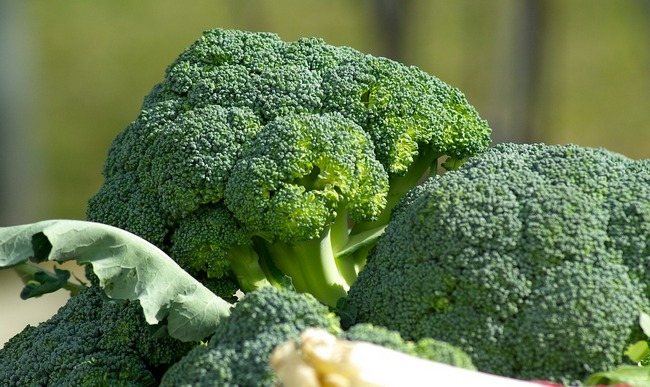
Colored
In third place is the no less famous color one. It is easily digested, combines a delicate taste and a whole list of essential vitamins. Although there is a small disadvantage for breastfeeding - the presence of purine substances. For those mothers who suffer from kidney problems, it is better to control the amount of product consumed.
Read also: Is it possible for a nursing mother to have decaffeinated coffee (with breastfeeding)
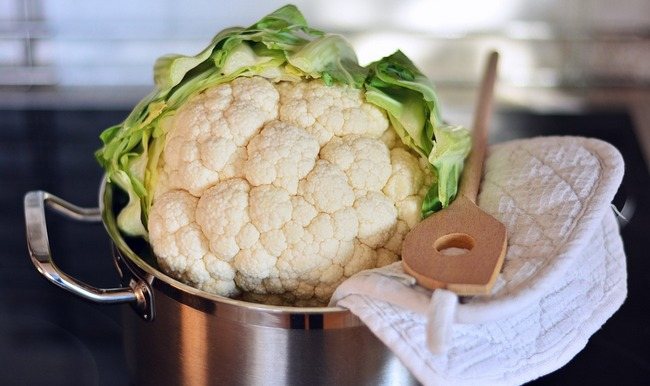
Red cabbage
It has surpassed its relative in the cabbage bed. What makes it valuable is the pigment cyanidin, which gives a bright purple hue. In turn, the pigment has a positive effect on blood vessels and improves the passage of blood through them.
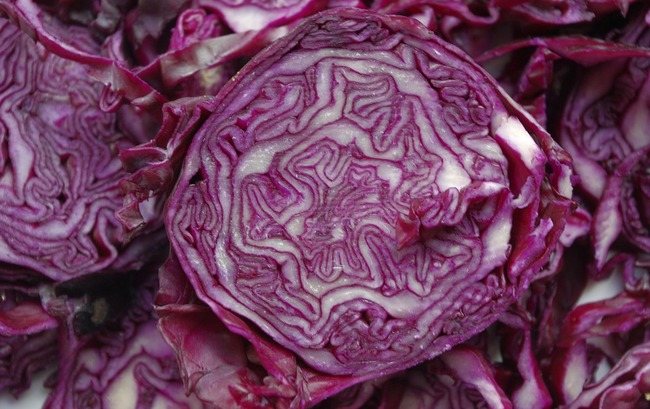
White cabbage
We have reached the most famous and popular. As you can see, this beauty is far from first on the list. Although this does not make it harmful or bad at all, it simply means that the presence of positive properties is slightly lower. Unlike other types, it is possible to pickle and eat fresh, preserving ascorbic acid in large volumes. She is the winner in the fight against winter vitamin deficiency.
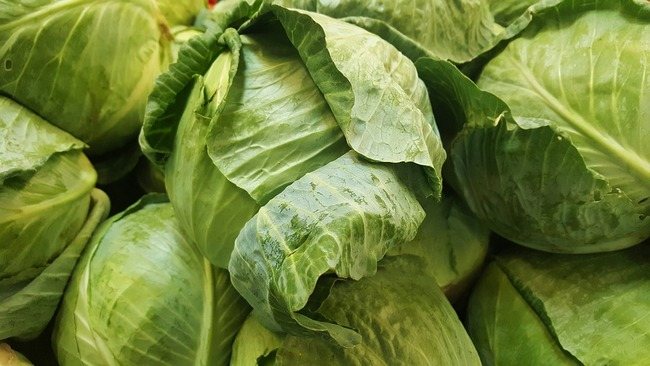
There is a significant disadvantage to breastfeeding, such as the formation of fermentation in the stomach after consumption. If a woman is on breastfeeding, it can be assumed that eating this type of crop will lead to obvious inconvenience. Stewed cabbage when breastfeeding a newborn, unfortunately, can cause colic in the baby. Painful sensations are clearly not necessary, which means including it in the diet only three to four months after childbirth.
Chinese
It looks interesting, has leaves, but does not have a head of cabbage. The composition is very close to the previous representative. The only negative is that it’s tasty to use only the leaves in a salad, and there are few of them. The stalk can be cut into Christmas tree strips and added to soups.
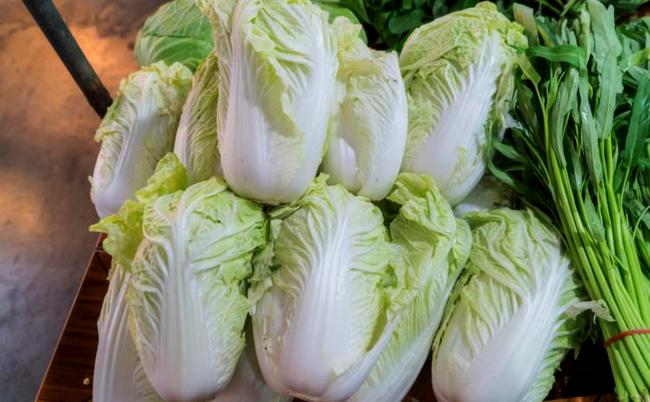
Marine
There is also a subspecies that is a plant, not a vegetable crop. Sea kale has been known since childhood and is famous for its high iodine content. When your baby reaches six months of age, you can eat valuable algae in limited quantities.
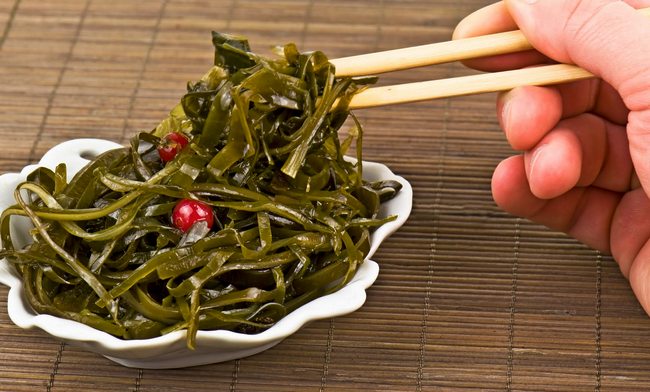
Is processed cabbage safe?
Cabbage can be processed in several ways - boiled, stewed, fermented. To make the dish as safe as possible, you need to cook it very carefully. When extinguishing, it is necessary to avoid burning the product. After all, during this, carcinogens are formed that are harmful to a nursing mother. Contraindications to eating stewed cabbage are also diseases of the pancreas, liver and intestines.
Irina, 26 years old: my first son did not react to raw cabbage in the second week after giving birth. I introduced the product early due to inexperience. But the second time I studied the issue and introduced it a month later, in stewed form, gas and colic bothered me the whole night. I didn’t dare eat cabbage again until the end of feeding.
Flatulence in a mother is also possible when eating a processed vegetable, but it occurs less frequently than after a raw product. So when introducing cabbage into the diet, it is better to process it.
There are restrictions on the use of sauerkraut. It contains a lot of acid, hot spices and salt. During the first year of breastfeeding, it is better for a nursing mother to give up treats completely.
Recommendations from experts
Stewed cabbage during breastfeeding is acceptable in the mother's diet if she does not have individual reactions to this product, which is extremely rare. Modern breastfeeding experts authoritatively assert that during breastfeeding you can eat almost everything that relates to proper and healthy nutrition. And colic in babies in most cases is a natural process that cannot be avoided. This is how the microflora in the child’s intestines is populated and its functioning is normalized.
All the food that a nursing mother eats affects the composition and even the taste of her breast milk. This is how the baby gets acquainted with a variety of tastes for the first time. It has been noticed that children whose mothers did not adhere to a strict diet are more willing to eat complementary foods and quickly switch to a common diet.
Therefore, it is definitely not worth giving up stewed cabbage during breastfeeding and other familiar dishes. But be careful. Nowadays, many children have allergies; they can have reactions to a variety of seemingly harmless products. An attentive mother will always notice that her baby is suddenly acting restless, has a tummy ache or has a rash. It is imperative to correlate this with the food you eat. It is likely that some products will have to be temporarily abandoned for now. And stewed cabbage is no exception.
Does variety matter?
Cauliflower is good for the body during breastfeeding because it contains fiber. It is quickly absorbed. Of all types of heat treatment, it is better to exclude frying so as not to lose the beneficial properties of the vegetable. Can be boiled and steamed.
The product contains a number of vitamins and microelements that are necessary for mother and child. The potassium and calcium content have a beneficial effect on tissue building and bone strengthening. Phosphorus, iron and zinc saturate the blood with oxygen and improve blood circulation.
Seaweed during breastfeeding is useful only in limited quantities. The coarse fiber contained in the product can lead to digestive problems. Large amounts of iodine often cause allergic reactions in infants.
Yulia, 23 years old, does not recommend eating seaweed: It took us a long time to get rid of allergies. The whole face was covered in red spots.
There is also no need to completely eliminate the product. The algae improves the functioning of the thyroid gland and normalizes stool. The liver and bile ducts are cleansed. Sea kale is not prohibited during breastfeeding. Amino acids and polyunsaturated fatty acids are necessary to strengthen the child’s body.
During breastfeeding, broccoli can be consumed in doses, in small portions, no earlier than two months after birth. If the mother has intestinal diseases, the product is completely contraindicated.
The vegetable contains vitamins PP, carotene and methionine, which have a beneficial effect on the functioning of the entire body. Harmful salts and metals are removed with the help of choline and phytin, which are part of broccoli. Intestinal function will improve due to fiber, and sulfur, zinc and beta-carotene will remove kidney stones.
Maria, 31 years old: I ate broccoli immediately after the maternity hospital and my baby responded well. I love this cabbage very much, but I ate it little by little. And introduced it gradually.
The influence of cabbage on the body of the mother and newborn during feeding is undeniable. For nursing mothers, it can be harmful and beneficial at the same time, since food tolerance is individual, and the content of beneficial microelements in the product is high. The main thing to remember is the basic principle of breastfeeding: introduce new foods into the diet in small portions and monitor the baby’s reaction to them.
Can a nursing mother eat cabbage?
There are many arguments for and against the inclusion of any food in a nursing mother's diet. It is also important to find out whether cabbage can be consumed while breastfeeding, because this vegetable is loved by many young women.
Most pediatricians are of the opinion that those foods that cause pathological reactions in the mother are also dangerous for the baby. There is another position: the intake of harmful substances from mother’s milk into the child’s body is extremely limited. A young mother should simply discuss any expansion of the diet with her doctor to prevent a pathological reaction to these foods in the baby.
Read in this article
What is better - fresh vegetables or cooked ones?
After a month of a strict diet, doctors allow you to gradually add light, fresh vegetables to the menu. Vegetable salads contain a large amount of vitamins and microelements; their healthy ingredients help to properly balance nutrition, harmoniously enrich the diet of a nursing woman and help gradually break out of a strict diet menu.
Salads made from fresh vegetables are easily combined with various products, sour cream, vegetable oil and are very appetizing and tasty.
A particularly valuable vitamin and mineral complex is contained in fresh cabbage. Cabbage contains the following beneficial substances:
- Vitamin A – normalizes vision.
- Vitamins B1, B2, B4, B6, B9 - strengthen all organs and systems.
- Vitamin C – participates in all processes of the body.
- Vitamin E – improves the functioning of the circulatory system.
- Microelements: potassium, sodium, magnesium, selenium - help normalize growth.
- Phytoncides are antimicrobial protection.
- Amino acids - participate in the production of hormones and enzymes.
Cabbage mainly consists of fiber and water and is a dietary vegetable that has an anti-inflammatory, antiviral, cleansing, healing effect, activating the growth and defenses of the body.
You should not eat cabbage if you have a peptic ulcer, allergies, enterocolitis, bleeding of the stomach or intestines, pancreatitis, or individual intolerance.
There are a large number of interesting recipes in cooking, however, in this case, we are considering salads that are recommended during lactation. But you need to start using them with great caution.
Ingredients
- White cabbage – 300 g;
- Carrots – 100 g;
- Vegetable oil – 0.5 tsp;
- Lemon juice – 0.5 tsp;
- Green apple – 1 pc.;
- Green onions (optional) – 2-3 stalks;
- Dill, optional – 2-3 branches;
- Salt, optional.
- Chop the cabbage into thin strips, grate the carrots, cut the apple into small slices, chop the greens.
- Place everything in a salad bowl, mix, lightly squeezing - the cabbage will become softer and release juice. Season with lemon juice and vegetable oil.
- Add a little salt.
This salad is good to eat for dinner; it perfectly helps cleanse the body of accumulated waste and toxins. You can replace the butter with low-fat sour cream. The taste will not be lost from this.
Using simple recipes, you can prepare interesting cabbage salads by replacing some ingredients with others or adding new ones. Boiled chicken, canned corn, green peas, and boiled potatoes go well with fresh cabbage. It all depends on appetite and personal preference.
We must not forget the main rule for a nursing mother: gradualness and small portions.
It is advisable to start eating cabbage salads after 2-3 months after giving birth. After morning feeding, try a couple of spoons of salad and carefully monitor the baby’s condition.
If there is no heaving or bloating in the tummy or excessive gas formation, you can slightly increase the portion every other day. If difficulties still arise, remove the dish from the menu, postponing its consumption for a month or two.
- Cauliflower and broccoli can be eaten after the third week of lactation. Sea - in three months. White cabbage begins to be introduced into the diet no earlier than four months;
- During the first six months of feeding, it is recommended to cook the cabbage in stewed form. You can add potatoes or carrots to the dish. However, carrots should be eaten with caution when breastfeeding, as due to their bright color they sometimes cause an allergic reaction. But frying food in the first months of lactation is not recommended. You can add vegetable oil to the finished dish;
- Add cauliflower and white cabbage to soups and broths. Warm liquid stimulates lactation. Remember that a nursing mother’s daily diet must include soup!;
- Be mindful of the dosage. Excess of even the most useful product leads to negative consequences. Be especially careful when eating seaweed, which can be eaten while breastfeeding no more than three times a week, 150 grams each. A serving of cauliflower or broccoli is up to 200 grams per day;
- If you are breastfeeding, you should not eat sauerkraut due to the spices and acid it contains!;
We invite you to familiarize yourself with: The best varieties of cauliflower for open ground: early and late. For the Moscow region and the middle zone
Before eating, choose your vegetables carefully, use only fresh ones! Poor quality products cause stool problems and severe intoxication in both mother and baby. Read here what other foods you can eat while breastfeeding.
A nursing woman should not sit on cereal alone. The diet of a young mother must be varied. White cabbage is considered one of the healthiest vegetables. It is rich in coarse fiber, and cleanses the intestines, helps with constipation, and promotes weight loss.
But you need to introduce it carefully, because it is a rather heavy product. At the beginning of life, the baby already suffers from colic. Pediatricians do not recommend introducing this vegetable in the first month of lactation. In the third or fourth week, you should try boiled white cabbage in soup. It is considered lighter than fresh or fermented, and is quickly absorbed. Start with two tablespoons and gradually increase to a full serving. If the colic intensifies, the vegetable must be temporarily removed from the mother’s diet.
Four months after the birth of the child, fresh cabbage is allowed. The main thing is to keep an eye on the baby, pay attention to his stool, gas, and eliminate the vegetable in time if it is not suitable.
It is generally accepted that gas-forming products through mother's milk cause colic in the baby. These include cabbage and the legume family.
But recent studies have shown that colic is not always a reaction to the “wrong” foods. Most often, this unpleasant condition means that the child is adapting to new realities, his intestines are populated by microflora. And adaptation is always difficult. Therefore, the contribution of gas-forming food to colic should not be exaggerated. It is much more important to avoid allergens, as they significantly worsen the child’s condition.
Stewed cabbage when breastfeeding a newborn is allowed on the menu from the third week of lactation. But it is important that it is prepared correctly - without strong spices (dill is fine), without ketchup, with a small amount of oil.
Pediatricians recommend introducing stewed cabbage first, but not fresh cabbage. It is easily digestible, hypoallergenic, and relieves mother from constipation. There are fewer vitamins and microelements in it than in fresh ones, but they are still there.
Sauerkraut during breastfeeding is allowed from the second half of the year. It should contain a minimum of seasonings and vinegar essence. It should be administered gradually and in small quantities during guardianship. “Kvashenka” is considered a source of folic acid and vitamin C. It has a beneficial effect on the intestines. To minimize the risk of gas formation in an infant, it is recommended to add cumin to the snack.
What if it's in soup?
For a nursing mother, it is useful to add cabbage to vegetable soup; in this form, it almost does not lose its beneficial properties and is well absorbed. From the sixth month of lactation, mommy can try cabbage soup. The main thing is to observe the child’s reaction and try new foods in small portions.
Cooking boiled cabbage is very simple. This does not require any special skills. The simplest cabbage recipe will help you prepare a tasty and healthy side dish for a nursing mother.
- White cabbage – 500 g;
- Salt to taste – 2 tsp.
- Wash the cabbage. Peel the vegetable from the top and damaged leaves. Cut into large pieces.
- To boil water. Add salt.
- Place the cabbage in the pan.
- Cook over low heat until soft (on average this takes about 15 – 20 minutes).
- Drain the liquid (it is better to use a colander).
Vegetables are certainly beneficial for any body. However, during lactation, eating them fresh is not recommended until at least 3–4 months after the birth of the child. In this case, boiled cabbage would be an excellent alternative when breastfeeding. Preserving almost all vitamins in this form, it is easily absorbed by a woman’s body and helps strengthen the immunity of mother and child, as well as improve many other body functions.
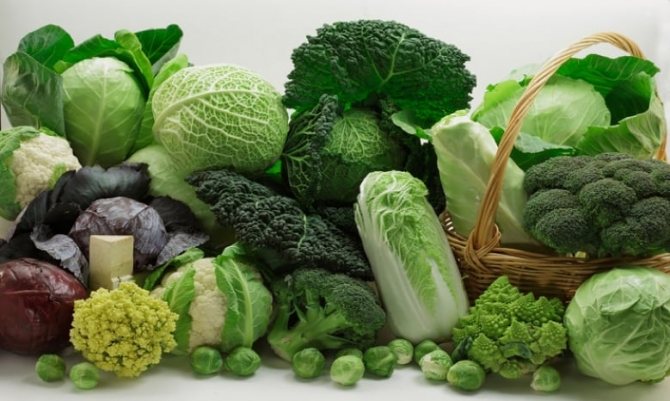
It is worth noting that there are many types of cabbage. Some are widely distributed, others do not often reach the table of the average consumer. The most common types of cabbage:
- White cabbage.
- Red cabbage.
- Colored.
- Broccoli.
- Kohlrabi.
- Brussels.
- Beijing.
- Chinese, etc.
Let's take a closer look at which varieties of cabbage are useful and which are not recommended during breastfeeding.
Cabbage contains a large amount of fiber, which is poorly absorbed by the body. In some cases, quite often, cabbage, consumed fresh, caused increased flatulence and intestinal discomfort in both mother and child. Nursing mothers are not recommended to eat raw vegetable leaves; it is better to heat them.
It is customary to introduce cabbage into the diet gradually, starting with adding leaves to soup and broth. If the response of the baby’s body is positive, then you can switch to stewed cabbage. Stewed broccoli and cauliflower, which have a beneficial effect on the body, have gained wide popularity.
But you should eat cabbage very carefully, in small portions. After heat treatment, the vegetable is easier to digest, while maintaining its beneficial properties.
Regarding sauerkraut, it is worth clarifying that it is not recommended for consumption during lactation. This is due to the increased acidity of the product, which can have a negative effect on the child’s body.
Salt and spices, which are generously seasoned with sauerkraut, can increase colic, lead to stomach upset and even poisoning. In addition, salt causes dehydration, and with a lack of fluid, breast milk production decreases.
If you still decide to use sauerkraut in your diet, then this should be done no earlier than 6-8 months after birth and only if the child has no digestive problems.
We suggest you read: Potato storage temperature and storage problems
Not all types of this gift of vegetable gardens are contraindicated during breastfeeding. Experts recommend that women include some varieties of cabbage in their diet from the first days after childbirth.
Cauliflower
This type of vegetable garden gift is known in medicine for its beneficial properties. When figuring out whether a nursing mother can eat cauliflower, an experienced pediatrician will most often advise her to introduce the product into her diet starting from 2 to 3 weeks after the start of breastfeeding.
Useful qualities of cabbage for mother and baby
Cabbage is one of those vegetables that are familiar to us, without which our diet is simply unthinkable. It is included in most dishes of Russian and Ukrainian cuisine. And this popular recognition of this fruit of vegetable gardens is completely no coincidence.
Cabbage contains a lot of useful substances. Most often, experts identify in its composition:
- A large number of .
This vegetable is rich in all B vitamins, and I especially want to note the increased content of B1 and B6. In addition, the queen of vegetable gardens contains vitamins A, E, H and PP. - Many experts emphasize the increased set of microelements contained in cabbage.
You can name chlorine, sulfur, nickel, zinc and other useful ingredients, without which the baby’s development may be at risk. - Separately, we should highlight the presence of copper, iron and fluorine in this gift.
These substances are extremely necessary for an infant for the development of his musculoskeletal system, as well as for the rapid progress of his central nervous system.
Most often, experts, when considering the positive aspects of this product, talk about whether white cabbage is needed during breastfeeding.
It is this vegetable that is most often used by young mothers as food, so the selection of useful substances is made specifically for this variety of cabbage.
If for some reason a nursing woman prefers not to include cabbage of this variety in her diet, she can safely use folk recipes for using the leaves for the treatment and prevention of inflammation of the mammary glands and normal engorgement of the nipples. The usual gift of the vegetable garden is considered an excellent means for the prevention and control of the mammary glands of a nursing woman.
Beneficial features
First you need to get acquainted with all the properties of this vegetable. Firstly, it contains a lot of vitamin C, iron, fiber, potassium and phosphorus. Secondly, the calorie content per 100 grams is only 38 calories. Carbohydrates 8 gr. Thirdly, it has an excellent effect on all systems and organs and supports the immune system.
So, can a young mother have Brussels sprouts during breastfeeding? Yes, you can.
If we talk about favorable factors affecting the body, there are a lot of them. Pros:
- Reduces cholesterol levels. indispensable for normal heart function, especially if the preparation is as simple as possible, without sauces, cheese and butter.
- It plays a special role for pregnant women, namely it reduces the risk of birth defects of varying degrees.
- Has a high content of folic acid.
- It has a beneficial effect on vision, thanks to the vitamin A in its composition. It supports vision well and prevents it from deteriorating.
- Beta-carotene in the composition is an excellent antioxidant, which reduces the risk of respiratory diseases.
- The presence of vitamin K supports brain activity.
- Prevents a terrible diagnosis - breast cancer. Researchers have proven that indole-3-carbinol inhibits and prevents the development of breast cancer cells.
- Fiber is a storehouse of benefits for breastfeeding, for the prevention of constipation and digestive problems.
- Representative of dietary cuisine. With a low calorie content, it gives a long-lasting feeling of fullness. Included in many low-calorie dishes.
- Does not cause fermentation, unlike its white cabbage counterpart.
When breastfeeding, you can diversify your meals with this vegetable crop. However, you should not lean on it, because any food is introduced gradually.
In small quantities during breastfeeding, it is allowed only for those who do not have problems with the stomach and acidity, as well as with the thyroid gland.
If you feel pain in the intestines after eating, it means that your stomach does not absorb this culture, although this happens quite rarely. Perhaps, if pain occurs, you need to contact a gastroenterologist for an examination.
Read also: Can a nursing mother have traditional anniversary cookies (for breastfeeding)?
Why are most pediatricians against
Many breastfeeding experts advise delaying the introduction of cabbage into the diet until the baby is 3 months old. Although there are opinions that such an experiment can begin 12 to 15 days after birth. The arguments on both sides are quite similar.
Doctors of the old school draw the attention of women to the fact that even for an ordinary healthy body, cabbage in any form is a rather complex food. If cabbage prevails in the diet of the average person, then problems with the functioning of the gastrointestinal tract will not keep you waiting. This vegetable causes excessive bloating, flatulence, etc.
It should be assumed that in a young mother, whose body’s defenses are weakened by childbirth, such a pathology may be most likely. That is why most doctors recommend delaying the inclusion of this vegetable in the diet of a nursing woman.
But it should be noted that fresh cabbage during breastfeeding may not have much effect on the baby’s digestion. Any new product introduced into a woman’s diet during lactation has a very individual effect on the baby.
That is why modern pediatricians advise mothers to gradually try to accustom their children to cabbage, given its rich content of valuable substances, vitamins and microelements. Of course, the mother needs to exercise maximum caution and at the first manifestation of intolerance to the vegetable by the child, the introduction into the woman’s diet should be stopped.
It should be noted that in nature there are more than 30 varieties of cabbage, and not all of them are harmful during breastfeeding. If you don’t like white cabbage, you can easily replace it with other varieties.
Watch the video about diet during lactation:
When is the ban on the consumption of certain types lifted during breastfeeding?
Cabbage is one of those vegetables that are familiar to us, without which our diet is simply unthinkable.
It is included in most dishes of Russian and Ukrainian cuisine. And this popular recognition of this fruit of vegetable gardens is completely no coincidence. Cabbage contains a lot of useful substances. Most often, experts identify in its composition:
- A large amount of vitamins. This vegetable is rich in all B vitamins, and I especially want to note the increased content of B1 and B6. In addition, the queen of vegetable gardens contains vitamins A, E, H and PP.
- Many experts emphasize the increased set of microelements contained in cabbage. You can name chlorine, sulfur, nickel, zinc and other useful ingredients, without which the baby’s development may be at risk.
- Separately, we should highlight the presence of copper, iron and fluorine in this gift. These substances are extremely necessary for an infant for the development of his musculoskeletal system, as well as for the rapid progress of his central nervous system.
Most often, experts, when considering the positive aspects of this product, talk about whether white cabbage is needed during breastfeeding.
It is this vegetable that is most often used by young mothers as food, so the selection of useful substances is made specifically for this variety of cabbage.
If for some reason a nursing woman prefers not to include this variety of cabbage in her diet, she can safely use folk recipes for using the leaves for the treatment and prevention of mastitis, inflammation of the mammary glands and normal engorgement of the nipples. The usual gift of a vegetable garden is considered an excellent remedy for the prevention of mastopathy and the fight against stagnation of milk secretion in the mammary glands of a nursing woman.
In general, experts recommend introducing cabbage into the diet no earlier than 3 weeks after birth. This is due to the fact that the child needs time to normalize the functioning of the gastrointestinal tract.
- Cauliflower and broccoli are considered easily digestible varieties and are allowed from the first month of a child’s life.
- Seaweed, rich in iodine, and Chinese cabbage are indicated for consumption from the age of 3 months.
- It is better to postpone eating white cabbage for at least six months, so as not to burden the mother’s fragile body with elements of coarse fiber.
Thus, it can be noted that by following the rules for gradually introducing vegetables into the diet, you can reduce the risks of negative consequences. It is also important to choose the right variety and method of preparation of the product, and follow the dosage of consumption.
If you find an error, please highlight a piece of text and press Ctrl Enter.
What should a nursing woman know about different varieties?
Not all types of this gift of vegetable gardens are contraindicated during breastfeeding. Experts recommend that women include some varieties of cabbage in their diet from the first days after childbirth.
Cauliflower
This type of vegetable garden gift is known in medicine for its beneficial properties. When figuring out whether a nursing mother can eat cauliflower, an experienced pediatrician will most often advise her to introduce the product into her diet starting from 2 to 3 weeks after the start of breastfeeding.
Cauliflower improves metabolism, strengthens the baby, and helps a young woman cope with postpartum central nervous system problems. The product reduces the risk of gastritis or peptic ulcers in a nursing mother, which is quite common among nursing women.
It is best to start introducing this vegetable product into a woman’s diet in the form of light decoctions or soups. After the first month has passed after birth, the mother is allowed to eat cauliflower stewed in olive or vegetable oil.
Broccoli
This variety of cabbage differs from most varieties in its increased content of vitamin A and folic acid. But this is not the most important thing!
When women ask whether a nursing mother can eat broccoli, they should say that it is not only possible, but also necessary. This variety of cabbage contains more vitamin C than oranges or lemons. The healing substance is extremely necessary for the successful development of the baby’s organs and systems.
Many doctors believe that high levels of ascorbic acid increase the risk of allergic reactions. In the case of broccoli, this rule is not confirmed.
Doctors recommend that women begin to introduce this variety of cabbage 20 to 25 days after birth. It is best to start with decoctions. Light soups based on the vegetable in question will help increase the immune defense of mother and child and stabilize their gastrointestinal tract.
Although broccoli is one of the safest varieties of cabbage, a young mother must be careful when eating it. Any type of cabbage is a rather insidious product, and pathological reactions on the part of the baby can occur at any time.
Sea kale
This type of vegetable is also very useful during lactation. Those who are breastfeeding can and even need seaweed. This variety improves metabolism at the cellular level, promotes the functioning of a woman’s thyroid gland, and helps stabilize the central nervous system of mother and baby.
It should be remembered that given the high allergic properties of this product, it can be included in the diet of a nursing mother no earlier than 3 months after birth. Sea kale can diversify a nursing woman's diet and solve the problem of vitamin saturation of the diet.
Beijing
Many experts agree that compared to white cabbage, this type of vegetable does not have a special effect on the baby and his mother. Peking cabbage during breastfeeding is approved for use from 3 months after birth.
The product in question is a storehouse of a large amount of vitamins and minerals. Vitamins of groups A, B, C and PP are extremely important for the growth of an infant. It should be noted especially the last substance; this vitamin promotes the rapid growth of the child’s nervous system.
Chinese cabbage is contraindicated for women suffering from stomach and intestinal diseases. The period of breastfeeding often causes changes in acidity in the stomach of a nursing mother, so this type of cabbage is not recommended for patients with such problems.
Brussels
According to most medical publications, this is an extremely useful product during lactation. Brussels sprouts are very necessary for mother and baby during breastfeeding:
- this product affects the immune system, helping to reduce the number of viral and infectious diseases;
- the variety enhances metabolism, increases the transfer of oxygen in cells, affects the hormonal system of a young mother;
- Brussels sprouts reduce the likelihood of blood clots in blood vessels and stabilize the activity of the heart muscle;
- For a baby, this product is important due to its direct effect on the growth of the bone skeleton and muscle mass.
The only contraindication for using Brussels sprouts as food during lactation is gastrointestinal diseases in the mother. Before introducing it into your diet, you should consult a specialist.
Cabbage during breastfeeding
Different varieties of cabbage, like other vegetables, must certainly be included in a woman’s diet, both throughout pregnancy and after the birth of the child. Cabbage is a source of nutrients, vitamins, and minerals. In addition, it can be eaten raw, boiled, stewed, or pickled.
Since this vegetable tends to cause excessive gas formation in the stomach and intestines, many inexperienced mothers have a logical question: “Is it possible to have stewed cabbage while breastfeeding? Will the baby get colic from such a “treat”?”
What do the doctor's say?
Let's start with the fact that we are not talking exclusively about white cabbage. Broccoli, Peking, Brussels sprouts, cauliflower - all these varieties are available for sale all year round, all are healthy and nutritious in their own way.
As for the harm that a dish of stewed cabbage can cause to a baby’s digestion, its degree is clearly exaggerated.
After all, the baby does not eat cabbage itself, but breast milk, so even if a nursing woman’s body’s reaction to this vegetable is inadequate, it is not a fact that the baby will experience bloating.
It is advisable to introduce it into the diet no earlier than after 2-3 weeks and only in limited quantities. In this case, you definitely need to observe the child’s reaction.
If after feeding he behaves restlessly and gives obvious signals of pain in the tummy, it is better not to eat cabbage.
As for stewed or boiled cabbage, the opinion of doctors is clear - a nursing mother can eat it, but, of course, in reasonable quantities. You need to be careful with raw cabbage (white, red), and for salads it is better to use more tender Chinese cabbage.
What you shouldn't eat at all is sauerkraut. Yes, it is tasty, very healthy, rich in vitamins, and many people love sauerkraut. But we must not forget that this product is quite “aggressive”, so the reaction of a child’s fragile body to it may be negative.
In addition, in addition to bacteria that cause fermentation, sauerkraut contains acid, and hot spices are often used for fermentation, so it is better to avoid such a snack completely when breastfeeding. You should not eat sauerkraut even if it is stewed before eating.
Sometimes inexperienced young mothers ask: “Is it possible to eat seaweed while breastfeeding?” In this regard, it is necessary to immediately make the remark that sea kale is not a vegetable crop and has nothing in common except the name with “land” varieties of cabbage. This is a special type of algae, so when breastfeeding, you need to eat it, like all other seafood, with caution, despite all its benefits.
After childbirth, the situation changes dramatically, since now everything that a nursing mother eats and then passes on to the baby through breast milk must be processed on its own.
Considering that the digestive system of an infant is imperfect, not everything can be eaten by the mother; even healthy vegetables have to be divided into those that are and are not allowed.
Each vegetable contains many vitamins and microelements, which, of course, are necessary for the baby’s body, but some of them, for example, due to their rich color, can cause an allergic reaction. Suppose beets contain iron, folic acid and even vitamin C, but due to their bright color, this particular vegetable can cause a rash on the baby’s face or body.
For example, cabbage is also a very healthy vegetable that contains ascorbic acid and vitamin B, but when it enters the baby’s body, even through breast milk and, of course, no longer in its pure form, cabbage causes abundant fermentation, which manifests itself in colic and bloating of the baby's tummy.
It is worth remembering garlic, as well as other spicy vegetables, which, despite their incredible health benefits, still affect breast milk and can change its taste, which will lead to unnecessary difficulties for both mother and baby. It is undesirable, especially in the first days after the birth of a child, to eat canned vegetables, which do not contain many useful substances and are characterized by an abundance of preservatives and vinegar essence.
As a rule, all doctors recommend that nursing mothers eat only those vegetables that grow in their place of residence and to which they have become accustomed since childhood.
This is due to the fact that in the body of each person certain types of enzymes are formed, which help process certain products.
Subsequently, the body’s ability to assimilate certain groups of foods is transmitted at the genetic level, and accordingly, a newborn child also possesses them.
But it is better to abstain from celery or fennel, even despite their usefulness, since these vegetables were not available to everyone 10-15 years ago, and accordingly, the mother’s body most likely will not have the necessary enzymes.
It should be noted that the diet of a nursing mother is subject to strict control precisely during the first weeks of the baby’s life; with each subsequent month, the baby’s body gets stronger and improves, and accordingly, it becomes possible to diversify the daily diet of both mother and baby, within reasonable limits, of course.
Many women are interested in whether a nursing mother can eat cabbage. Doctors do not advise eating the cabbage variety before three to four months, because it often increases the formation of gases in young children. But broccoli and cauliflower are allowed in the first seven to ten days of lactation.
These are healthy, hypoallergenic and safe vegetables for a newborn, which are included in the diet of a nursing woman and in the first feeding of a child. But before we determine whether stewed cabbage is possible while breastfeeding, let’s consider which varieties to choose and in what form to eat them.
White cabbage includes ascorbic (vitamin C) and folic (B9) acid, which is very important for every body. But such a vegetable often increases the formation of gases, increases colic and flatulence in the newborn. Therefore, it is not recommended for use until the baby’s body adapts and the colic goes away. As a rule, this occurs after three to four months.
You can add fresh vegetables in small dosages to soup already in the second or third month. And eat stews after four. This vegetable perfectly relieves swelling and eliminates chest pain, prevents lactostasis. Therefore, many mothers use cabbage leaf compresses.
We suggest you familiarize yourself with When cabbage is harvested from the garden in the Moscow region: harvest times in different regions, features of harvesting for the winter, step-by-step instructions
Broccoli improves the functioning of the intestines, and cauliflower improves digestion, cleanses the intestines and the body, and is an effective prevention of cancer, gastritis and ulcers. Both types effectively increase immunity and protect against viral diseases, relieve stress and energize.
Sea kale is not a vegetable, but an algae. And, as you know, seafood is not recommended for a nursing mother in the first months, because they often cause food allergies in both children and adults. Therefore, the product should not be administered earlier than three months.
Sea kale can be eaten occasionally in small dosages when the baby reaches six months of age. Seafood fills the body with iodine, which is important for the functioning of the thyroid gland. They improve metabolism, regulate the functioning of the heart and strengthen blood vessels, improve blood composition and prevent blood clots, and stimulate memory.
Sauerkraut, like other marinades or pickles, is contraindicated for a nursing mother. Such products contain a lot of spices and acid. This can lead to poisoning and digestive disorders.
And then you can occasionally eat pickles in limited quantities, while increasing your drinking water intake to support breastfeeding.
The introduction of any type of cabbage into the diet of a nursing mother begins with broths and soups. Then they gradually include stewed and boiled dishes, and later fried ones. After heat treatment, vegetables are easier to digest and digest, while they retain the beneficial properties of a fresh product. Therefore, stewed cabbage is both healthy and safe during breastfeeding.
It has a lot of important properties:
- Has a general strengthening effect and improves immunity;
- Regulates cholesterol levels;
- Strengthens blood vessels and regulates hematopoiesis;
- Removes toxins from the body;
- Helps with constipation and improves bowel function;
- Protects the retina from the negative effects of ultraviolet radiation;
- Increases performance, gives strength and vigor;
- Improves the functioning of nerve cells and helps with stress;
- Reduces the risk of cancer and blood clots;
- Develops memory and is a good prevention of sclerosis;
- Improves the condition of skin, hair and nails.
But due to the increased acidity, stewed cabbage is contraindicated for ulcers, gastritis and colitis, for serious stomach problems and intestinal spasms. The product can cause a strong influx of gastric juice, which will further aggravate such diseases. In addition, you should limit your consumption of this vegetable if your newborn has severe colic.
How to cook cabbage for a young mother
Most often, this vegetable is recommended to be introduced into the diet of a nursing woman in boiled or raw form. Some experts believe that stewed cabbage is most suitable for first trials during breastfeeding.
However, we should make a reservation right away. We are not talking about a white vegetable, which can cause digestive disorders in a baby or young mother.
A similar heat treatment is usually recommended for cauliflower or broccoli. These varieties of the popular garden gift are least likely to cause allergic reactions in a baby, and after stewing in vegetable or olive oil, such cabbage is allowed for women after 10 days of breastfeeding.
The dish contains a lot of acid and salt, as well as numerous seasonings, which give sauerkraut a completely unique taste. Of course, for an ordinary person this dish is a delicacy, but for a nursing mother it is strictly prohibited.
Sauerkraut is allowed for breastfeeding women only after breastfeeding has stopped.
The little man does not have a strong enough immune system not to react to such an irritant.
In conclusion, I would like to emphasize that cabbage is one of the most controversial products on our table. Possessing a huge supply of vitamins and microelements, the vegetable in question can at the same time create a lot of troubles and health problems for the human body. That is why the introduction of cabbage into a nursing woman’s diet must be supervised by her doctor.
Any variety of cabbage, be it white cabbage, Brussels sprouts or cauliflower, if grown without the use of harmful additives, includes a large number of elements that have a beneficial effect on the human body. In some people, this vegetable provokes flatulence, but this is more likely due to the characteristics of their digestive tract - high sensitivity or some kind of disease. Many mothers during breastfeeding are afraid to use cabbage in their diet, associating it with the occurrence of colic in the child.
There is an opinion that if cabbage provokes fermentation in the mother’s stomach, then the child will have the same reaction. This judgment has a right to exist, especially if a woman is going to start feeding her baby cabbage. But basically, colic is the baby’s body’s response to the activity of bacteria in the digestive system that have entered it from the environment.
Should Brussels sprouts be included in the diet during lactation?
Unfortunately, many nursing mothers are confident that eating any cabbage, including Brussels sprouts, can cause bloating, intestinal colic and flatulence in the baby. In fact, Brussels sprouts are not capable of harming the health of a little person if they are consumed during lactation in boiled or stewed form.
The negative impact of Brussels sprouts on the baby’s digestive tract is greatly exaggerated, because the baby does not directly consume the vegetable as such, but is fed with mother’s milk. And even if a mother experiences fermentation in her stomach after eating cabbage, this does not mean that its onset is inevitable in the child.
Laboratory tests have shown that Brussels sprouts contain no substances that could negatively affect the health of an infant. Among other things, Brussels sprouts have a very low calorie content, which is very important for nursing mothers who want to regain their former slim figure.
How to properly introduce the product into your diet
The likelihood of an allergy in a baby to cabbage is negligible, but you should not ignore the possibility of its manifestations.
— This vegetable should be introduced into the menu of a nursing woman, like any other new product for her child, with extreme caution.
— It is necessary to closely monitor the condition of the baby’s skin and his stool.
— Healthy skin, mucous membranes, normal functioning of the excretory system will tell the mother whether she can eat this vegetable.
- A rash, upset stomach or constipation in a child indicates a food intolerance and, in all likelihood, an allergy.
Fresh cabbage for breastfeeding
Fresh white cabbage is an excellent source of vitamin C and various beneficial substances. But still, it should be consumed with caution while breastfeeding. Both fresh and stewed, it most strongly causes bloating.
. Juicy cabbage leaves, beaten until the juice is released, can quickly relieve breast condition at the first signs of mastitis or reduce the inflammatory process associated with poor breast emptying after feeding or pumping.
Sauerkraut for breastfeeding
The main limitation when breastfeeding is sauerkraut, although it contains an abundance of healthy ingredients, including natural antibacterial agents. But in this case, there may be an adverse effect on the child’s digestion. This is due to the presence of acid and all kinds of seasonings used to ferment vegetables in the dish.
It will be better for the baby if the mother puts aside sour and salty foods for a while until the end of feeding. And if the mother still decides to eat a little sauerkraut, then it is better to add a pinch of cumin to it
. This will add piquancy to it and reduce the likelihood of gas formation in the intestines.
Cauliflower while breastfeeding
Cauliflower has a delicate texture and contains virtually no tough fiber. This explains its good effect on the gastrointestinal tract of both the nursing mother and the baby. Its use has a beneficial effect on the functioning of the biliary system and liver, and also helps to normalize stool.
When the baby is 2-3 weeks old, mommy can cook cauliflower soup for herself - due to the low fiber content, this dish is perfectly absorbed by the body. A delicious dish made from boiled cabbage inflorescences baked in the oven. But frying while breastfeeding is not the most successful means of heat treatment of any food.
Sea kale for breastfeeding
This product will undoubtedly be useful for the child and mother if they have a deficiency of iron or phosphorus. Kelp, like all seafood, is rich in iodine, which is the main element for the activity of the thyroid gland.
Remembering that excess iodine is no less harmful than its deficiency, a nursing mother’s diet should include no more than 150 grams of kelp per week. In addition, seaweed during breastfeeding can provoke allergies in a child.
.
Brussels sprouts for breastfeeding
Brussels sprouts contain many beneficial substances. These are sugars that provide energy for the body, proteins, and many vitamins and minerals. It is not capable of harming the baby if it is eaten, boiled or stewed.
Brussels sprouts should be included in the diet carefully, starting with a small portion, which can be gradually increased in the future if the baby has no problems.
When breastfeeding, it is not recommended for mother to eat this type of cabbage until the baby reaches three weeks of age.
It is acceptable to include other types of cabbage in the menu: kohlrabi, Savoy, Peking, broccoli.
There is no need to be afraid of consuming cabbage, but you should not overuse it either. When deciding to introduce a particular type of cabbage into a woman’s menu, first of all pay attention to the baby’s well-being and his reaction. If, nevertheless, the child develops colic and allergies, then consumption of the vegetable should be limited during breastfeeding.
Video about the benefits of cabbage
To date, there is no consensus on how cabbage during breastfeeding affects the body of mother and child. Until recently, all pediatricians unanimously convinced parents that allergic reactions and colic could occur because of it. However, they say abroad that after the baby is born, you can eat all the usual foods. This is one of the most important principles of healthy eating, which guarantees proper growth and development. A nursing mother can eat cabbage. Attention should be paid to the method of preparation and the freshness of the product. Only in this case the baby’s body will receive only positive components, vitamins and minerals.
How to properly introduce stewed cabbage into the diet of a nursing mother
After the birth of a baby, you should be very careful with the introduction of many foods into your diet. It is necessary to try to consume this or that vegetable in a minimal amount and at the same time observe the reaction of the baby’s skin. The following signs indicate food intolerance in an infant:
- constipation;
- diarrhea;
- skin rash;
- nervous restlessness;
- stomach pain;
- allergy.
We invite you to familiarize yourself with Instant Sweet Cabbage with Beetroot. Instant pickled cabbage with chunks of beets. Putting vegetables in a jar
Any manifestation of an allergic reaction indicates that the baby is intolerant to cabbage. However, this is such a rare occurrence that it is unlikely that every mother will experience an allergy to cabbage. The vegetable does not cause an allergic reaction in children and is indicated for use in all child care institutions.
You can introduce cabbage into the mother’s diet as early as the second week after birth. However, only in stewed form. There are many delicious recipes for preparing cabbage, so many nursing women will like the dish. You cannot stew cabbage with ground pepper and other spices. This can cause heartburn and irritation of the stomach lining.
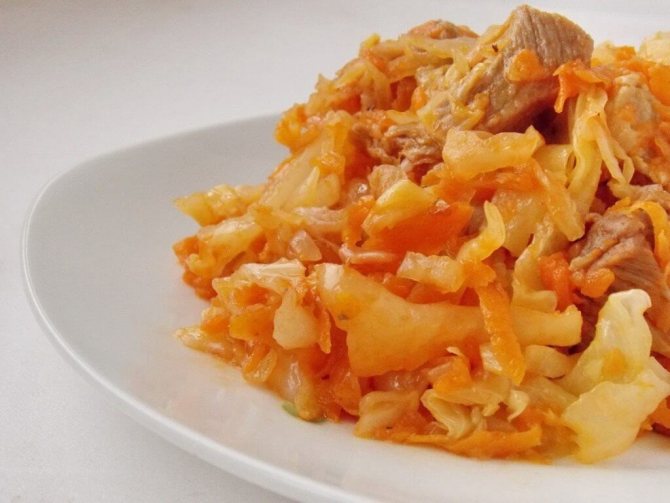
Is it possible to have stewed cabbage during gw? Yes, we just choose at the market or in the vegetable department of the supermarket a young, fresh, dense, light green head of cabbage without deformations or black spots.
At first, we cook cabbage without vegetable oil, only with the addition of water and a minimum amount of salt.
You can add a bay leaf, but not spices, which can cause heartburn. If your baby is already accustomed to accepting carrots and onions through breast milk, you can add some of these vegetables.
Shredded vegetables, simmered over low heat for 20-30 minutes under a lid, are already a ready-made dish. Such a snack during breastfeeding should be included in the menu in micro portions.
For the first time, you can try 1-2 spoons of stewed cabbage after morning feeding and then take a break for 3-4 days.
At the same time, you should carefully monitor changes in the baby’s well-being. If colic, bloating, or flatulence do not appear, then in the following days you can eat several tablespoons of cabbage.
The next time you prepare stewed cabbage, you can experiment and combine it with boiled potatoes, zucchini, chicken and other permitted products. Thus, based on observations of the baby’s health, we can conclude whether stewed cabbage should be left on the menu and whether it can be consumed while breastfeeding.
Any negative manifestations in the form of a rash, fever, gastrointestinal problems, or anxiety in a newborn indicate an intolerance to the new product, and the mother needs to remove this vegetable from the diet.
In this case, a consultation with a pediatrician is necessary and, most likely, his answer to the question of whether a nursing mother can have stewed cabbage will be negative.
Useful properties of the product
White cabbage should be included in your diet due to the large amount of vitamin C it contains. When consumed, the body receives a whole vitamin complex, folic acid, calcium, sulfur, aluminum, zinc and many other elements. Glucose, fructose and sucrose are necessary for the proper functioning of all internal organs.
Is it possible to have stewed cabbage while breastfeeding? GW specialists recommend including small portions in the diet. After this, you should carefully monitor the baby’s reaction and stop using in case of bloating, colic or other negative reactions.
It is allowed to eat Chinese cabbage in stewed form.
It is recommended to eat fresh broccoli as it is rich in zinc, iron, selenium and magnesium. Beta-carotene is used by the body to maintain beauty and youth. The component is also necessary for maintaining vision over time. Regular use of the product will give mommy a boost of vigor and energy.
Broccoli is a dietary product that helps people lose extra pounds. Mommy can eat it to prevent the accumulation of cholesterol in the blood. Thanks to regular consumption of the product, the walls of blood vessels become strong. The functioning of the heart and nervous system improves. For a woman, an additional advantage will be improved immunity, which helps to resist a large number of diseases.
Boiled cabbage is also used for compresses on the mammary glands. It helps against engorgement and stagnation. The method is used as a prophylaxis for mastopathy.
Can a nursing mother eat cabbage?
https://www.youtube.com/watch?v=7Sjgtw3L3iE
To date, there is no consensus on how cabbage during breastfeeding affects the body of mother and child. Until recently, all pediatricians unanimously convinced parents that allergic reactions and colic could occur because of it.
However, they say abroad that after the baby is born, you can eat all the usual foods. This is one of the most important principles of healthy eating, which guarantees proper growth and development. A nursing mother can eat cabbage. Attention should be paid to the method of preparation and the freshness of the product.
Only in this case the baby’s body will receive only positive components, vitamins and minerals.
We invite you to familiarize yourself with the growth of Scots pine
White cabbage should be included in your diet due to the large amount of vitamin C it contains. When consumed, the body receives a whole vitamin complex, folic acid, calcium, sulfur, aluminum, zinc and many other elements. Glucose, fructose and sucrose are necessary for the proper functioning of all internal organs.
Is it possible to have stewed cabbage while breastfeeding? GW specialists recommend including small portions in the diet. After this, you should carefully monitor the baby’s reaction and stop using in case of bloating, colic or other negative reactions.
It is allowed to eat Chinese cabbage in stewed form.
It is recommended to eat fresh broccoli as it is rich in zinc, iron, selenium and magnesium. Beta-carotene is used by the body to maintain beauty and youth. The component is also necessary for maintaining vision over time. Regular use of the product will give mommy a boost of vigor and energy.
Broccoli is a dietary product that helps people lose extra pounds. Mommy can eat it to prevent the accumulation of cholesterol in the blood.
For a woman, an additional advantage will be improved immunity, which helps to resist a large number of diseases.
Boiled cabbage is also used for compresses on the mammary glands. It helps against engorgement and stagnation. The method is used as a prophylaxis for mastopathy.
When breastfeeding, you can only eat foods that have been grown without the use of prohibited drugs. White cabbage contains many vitamins and minerals. Brussels sprouts and cauliflower can also be eaten during diets.
Doctors recommend that women after childbirth follow a strict diet during the first weeks so as not to harm the development of the newborn’s digestion.
Is stewed cabbage allowed during breastfeeding? How long after the baby is born can dishes made from it be included in the diet of nursing women? Will it complicate the adaptation process? In the second month of lactation, pediatricians allow the consumption of stewed cabbage; it is well digestible, has many beneficial qualities, and does not cause allergies.
» Nursing mother » Can a nursing mother cook stewed cabbage?
Certain foods can also cause allergic reactions in both a woman and her child. Sometimes questions arise as to whether a particular product or dish can be consumed.
Today we will talk about whether it is possible to have stewed cabbage while breastfeeding.
Brussels
It turned out to be the most valuable. It contains three times more vitamin C than its “brothers”. For those who suffer from hypertension, this vegetable is especially indicated, because it contains potassium. Rich in essential folic acid.
Broccoli
Broccoli deservedly takes second place. Contains carotene and high-quality vegetable proteins. With their help, cholesterol levels are lowered.
Just like Brussels sprouts, it does not cause excessive gas formation and digestive problems, which often causes inconvenience and discomfort to a person. It is worth noting that this fruit is recommended for a woman who has chosen breastfeeding.
When starting complementary feeding, your baby can be given broccoli puree within a week, after zucchini.
Colored
In third place is the no less famous color one. It is easily digested, combines a delicate taste and a whole list of essential vitamins. Although there is a small disadvantage for breastfeeding - the presence of purine substances. For those mothers who suffer from kidney problems, it is better to control the amount of product consumed.
Red cabbage
It has surpassed its relative in the cabbage bed. What makes it valuable is the pigment cyanidin, which gives a bright purple hue. In turn, the pigment has a positive effect on blood vessels and improves the passage of blood through them.
White cabbage
We have reached the most famous and popular. As you can see, this beauty is far from first on the list.
Although this does not make it harmful or bad at all, it simply means that the presence of positive properties is slightly lower.
Unlike other types, it is possible to pickle and eat fresh, preserving ascorbic acid in large volumes. She is the winner in the fight against winter vitamin deficiency.
There is a significant disadvantage to breastfeeding, such as the formation of fermentation in the stomach after consumption.
If a woman is on breastfeeding, it can be assumed that eating this type of crop will lead to obvious inconvenience.
Stewed cabbage when breastfeeding a newborn, unfortunately, can cause colic in the baby. Painful sensations are clearly not necessary, which means including it in the diet only three to four months after childbirth.
Chinese
It looks interesting, has leaves, but does not have a head of cabbage. The composition is very close to the previous representative. The only negative is that it’s tasty to use only the leaves in a salad, and there are few of them. The stalk can be cut into Christmas tree strips and added to soups.
Marine
There is also a subspecies that is a plant, not a vegetable crop. Sea kale has been known since childhood and is famous for its high iodine content. When your baby reaches six months of age, you can eat valuable algae in limited quantities.
Benefits and harms
The introduction of any variety of inflorescences into the menu of a young mother when breastfeeding begins, as a rule, with soups and broths. Then you can stew or steam, but frying is strictly not recommended.
When heat treated, vegetables gain the ability to be digested better and absorbed faster.
The beneficial properties are preserved, which means that stewed cabbage is not prohibited for a nursing mother and is completely safe.
It has a lot of useful features:
- strengthens the immune system and has a general strengthening effect;
- regulates cholesterol levels in the blood;
- removes toxins;
- strengthens blood vessels;
- protects the retina of the eyes from the negative effects of UV rays;
- struggles with loss of strength;
- reduces the risk of blood clots and cancer cells;
- helps prevent sclerosis;
- improves the condition of skin, hair and nails.
Due to increased acidity, consuming stewed inflorescences is not recommended for people with ulcers or gastritis, or intestinal spasms. In this case, it is better to abandon the vegetable or consult a specialized doctor. If your baby has signs of colitis, then it is also necessary to limit consumption.
To begin with, give preference to broccoli and cauliflower, and then you can add white cabbage, but gradually. When you try the dish for the first time, limit yourself to a small portion. Now, it is important for you to understand how the baby reacts to a new addition to the diet. If stewed cabbage during breastfeeding does not cause allergic reactions or anxiety in the child, you can include it in the diet.
It is important that the feeding portion should be 150-200 grams, no more than 2-3 times a week.
Seasonings for stewed and boiled foods include salt, pepper, bay leaf, parsley and dill. Other spices and herbs are not recommended.
Myth or reality
When breastfeeding, you can only eat foods that have been grown without the use of prohibited drugs. White cabbage contains many vitamins and minerals. Brussels sprouts and cauliflower can also be eaten during diets.
Unfortunately, even in adults, cabbage often causes excessive gas and bloating. However, this only happens in individual cases for each person. Most often, this indicates the presence of individual sensitivity to components or pathologies in the gastrointestinal tract.
This is why almost all women avoid eating cabbage during breastfeeding. Thanks to this, it is possible to prevent colic and excessive gas production in the baby.
Cabbage is a vegetable that can lead to fermentation in the stomach of not only the mother. The child receives a product that has already been carefully processed, so the likelihood of a negative situation is minimized.
When breastfeeding, colic occurs due to the penetration of foreign bacteria into the intestines. The process is produced from the environment, so it is almost impossible to prevent it. To date, no direct link has been identified between foods and colic. Their intensity and presence may be determined by other factors.
Sea kale is good for the body of mother and child
Basic rules of use
Cabbage is an eaten product that is harmful only if the baby is allergic to it. We should not forget that it is allowed to eat only fresh vegetables and fruits. If their shelf life has expired, the baby may get serious food poisoning.
The likelihood of an allergy is low, but it should not be ignored. Vegetables are introduced into the diet gradually. After this, it is necessary to observe the appearance and well-being of the baby for several days. Attention should be paid to the condition of the skin and stool. The negative reaction manifests itself primarily here. If you have a rash, diarrhea or constipation, cabbage is completely excluded from the diet for another month. If allergy symptoms have been recorded, then the vegetable should not be tried for another six months. It is not recommended to eat Chinese cabbage because it contains a lot of seasonings. They negatively affect the functioning of the baby's digestive system.
